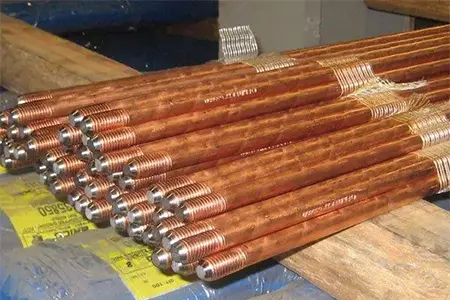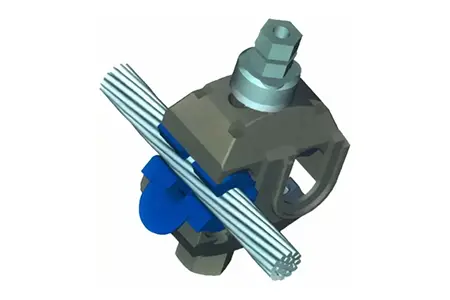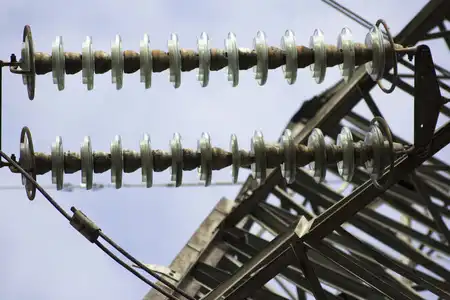4 Types of Copper Bonded Earth Rods: Ensuring Safety with Strength
Do you know what can help protect you and your appliances from fault currents? Metal rods are called grounding rods. These copper rods create quality grounding systems in overhead and underground distribution and transmission networks. They provide ground contact in all soil conditions, such as high-voltage substations, towers, and distribution applications. This grounding copper rod dissipates fault currents to the ground for safety. Let’s take a look at the different types of copper rods used for grounding.
4 Types of Copper Bonded Earth Rods
Copper rods for earthing are an important component used to establish a safe and effective earthing connection, which helps dissipate the current safely to the ground. These rods are designed by the IEC 62561 Part 2 standard, ensuring that they follow the highest quality and safety measures. They are made from 99.9% pure electrolytic copper bonded to a durable mild steel core with enhanced mechanical tensile strength and excellent corrosion resistance.
This makes them particularly suitable for use in areas with high soil resistivity or in environments with high salt content, where conventional solid copper or stainless steel rods may not perform. These ground rods ensure a low resistance connection to the ground, which is essential for maintaining the integrity of electrical systems and preventing potential electrical hazards.
Copper Bonded Earth Rods – Male Threaded
Copper-bonded earth rods (unthreaded and pointed) are essential components designed for effective earthing systems. The core of these rods is high-strength mild steel, chosen for its durability and strength. Around this core, each rod is meticulously bonded with 99.9% pure electrolytic copper to ensure superior conductivity and corrosion resistance.
Copper Bonded Earth Rods – Unthreaded and Tipped
Copper-bonded ground rods (unthreaded and pointed) are the basic components designed for effective grounding systems. The core of these rods is high-strength mild steel, chosen for its durability and strength. Around this core, each rod is meticulously bonded with 99.9% pure electrolytic copper to ensure superior conductivity and corrosion resistance.
Pure Copper Grounding Rods – Female Thread
Pure copper ground rods with internal threads are made from hard-drawn, high-conductivity copper. This material was chosen for its excellent conductivity, making these rods ideal for grounding applications that require the highest conductivity. The female thread allows for easy connection and extension, ensuring a safe and efficient grounding system.
Pure Copper Grounding Rods – Male Thread
Pure copper earthing rods with external threads are made from solid copper, specifically selected for their high conductivity and resilience, making them ideal for environments with high salt and moisture content. To further increase their durability and longevity, these rods are coated with tin, which significantly reduces the risk of oxidation and thus extends their service life. The threads on these rods are made using the rolled thread method, a process that not only strengthens the threads but also minimizes the risk of thread chipping during installation.

Applications for Copper Bonded Earth Rods
Copper Bonded Earth Rods are recognized for their versatility and effectiveness in a variety of grounding applications. Each application is described in detail below:
Suitable for a wide range of soil conditions:
these rods are the preferred solution for earthing in a wide range of environmental conditions, including wet, alkaline, salty, and acidic soils, as well as areas susceptible to chemical corrosion. Copper bonding ensures high electrical conductivity and resistance to these harsh conditions, allowing them to reliably ensure safety and equipment protection in a variety of environments.
Chemical plants:
In environments with frequent chemical reactions, the risk of electrical and electrostatic discharges can be very high. Copper grounding rods provide a safe path for such discharges, reducing the risk of fire, explosion, or damage to sensitive equipment. Their corrosion-resistant properties are particularly beneficial in preventing degradation from chemical exposure.
Refineries and power plants:
These facilities are characterized by heavy electrical equipment and high-voltage operations with a high risk of electrical hazards. The use of copper grounding rods ensures that a reliable grounding system is capable of handling high currents, thereby protecting the infrastructure and personnel from electrical faults.
Railroads and Telecommunications:
The integrity of railroad signaling systems and the reliability of communications infrastructure are critical. Grounding rods play a vital role in protecting these systems from lightning strikes and power surges, ensuring uninterrupted service and safety.
Water Treatment and Pumping Stations:
These installations are often located in environments with high humidity, which increases the risk of electrical failure. The use of copper grounding rods can help mitigate these risks by providing a reliable grounding mechanism, which is critical to the operational safety and efficiency of these facilities.
Broadcasters and Data Centers:
For broadcasters and data centers, maintaining the integrity of electronic equipment is critical. Copper grounding rods help protect this sensitive equipment from external electrical interference, including lightning, ensuring continuity of operations and data integrity. Telecommunications, Process Control, and AutomationIn the telecommunications and automation systems sector, grounding is not only critical for safety but also for signal accuracy and reliability. These poles ensure that systems are protected from electrical noise and surges that can interrupt communications and automation processes.
Digital Switches for Home and Remote Facilities:
These rods are an integral part of the grounding system for digital switches used in home automation and remote control facilities, including the petrochemical, LNG, and nuclear energy sectors. They ensure that these sensitive electronic devices are protected from electrical surges, thereby improving their performance and service life.
Petrochemical, LNG, and nuclear energy facilities:
In these high-risk environments, where the risk of electrical and electrostatic discharges is amplified by the presence of flammable materials or critical processes, copper ground rods provide a safe and effective path to ground, mitigating the risk of explosion or equipment failure.
Transformer Neutral Grounding:
Transformer neutral grounding is a critical aspect of managing fault currents and preventing voltage spikes. These rods ensure a stable and low-resistance path to the ground, which is critical to protecting the transformer and the stability of the grid.
Manufacturing Facilities and Refineries:
In these industrial environments, grounding rods are critical for protecting heavy machinery and electrical installations from lightning strikes and power surges, ensuring uninterrupted production processes and preventing potential damage.
Data Centers, Telecommunications, and Broadcasters:
For these industries, it is critical to maintain operational integrity and protect sensitive equipment from electrical noise and surges. Copper grounding rods play an important role in grounding systems to prevent data corruption and signal interference, ensuring reliability and continuity of service.
Process Control and Automation, Hospitals, CNC Machine Tools:
In environments where accuracy and reliability are critical, such as in process control systems, healthcare facilities, and CNC machining operations, grounding rods ensure that electrical and electronic equipment is protected from unexpected electrical interference, maintaining operational accuracy and safety.
Lightning Protection Systems:
These rods are the foundation of a lightning protection system, providing a direct path for lightning strikes to safely dissipate to the ground, thereby protecting buildings, people, and electrical systems from the potentially damaging effects of lightning.
Generators, Telecom Towers, and Microwave Antennas: For power generation facilities, telecom infrastructures, and microwave antennas, grounding is critical not only for operational efficiency but also for safety. Copper grounding rods ensure that these installations have a reliable grounding system to handle power surges and maintain uninterrupted service.

All Types of Copper Bonded Earth Rods
1. Solid Copper Bonded Earth Rods:
These rods feature a solid copper core, providing excellent conductivity and corrosion resistance. They are ideal for high-impact environments and are known for their durability and long lifespan.
2. Threaded Copper Bonded Earth Rods:
Threaded rods offer easy installation and versatility. They can be connected with various fittings and accessories, making them suitable for diverse grounding applications.
3. Sectional Copper Bonded Earth Rods:
Sectional rods consist of multiple segments that can be easily assembled on-site. This design facilitates transportation and installation in areas with limited access.
4. Copper-Bonded Steel Earth Rods:
Combining the strength of steel with the conductivity of copper, these rods offer a balance of durability and performance. They are commonly used in industrial and commercial settings.
5. Exothermic Welded Copper Bonded Earth Rods:
Exothermic welding ensures a robust connection between the copper and steel core of these rods, enhancing their longevity and reliability in grounding systems.
6. Ultrasonic Welded Copper Bonded Earth Rods:
Utilizing ultrasonic technology, these rods achieve a strong bond between the copper layer and the steel core. They are resistant to corrosion and mechanical stress.
7. Copper-Bonded Grounding Electrodes:
Grounding electrodes, bonded with copper, provide a low-impedance path for fault currents. They enhance safety by efficiently dissipating electrical charges into the earth.
8. Galvanized Copper Bonded Earth Rods:
Galvanized rods are coated with zinc for added corrosion resistance. They are suitable for outdoor installations and harsh environmental conditions.
9. Bare Copper Bonded Earth Rods:
Bare rods without additional coatings offer high conductivity and are commonly used in residential, commercial, and industrial grounding systems.
10. Copper-Bonded Lightning Protection Rods:
Designed to protect structures from lightning strikes, these rods divert electrical currents safely into the ground, preventing damage and ensuring occupant safety.
In conclusion, the diverse types of copper-bonded earth rods cater to various needs and environments, providing a robust grounding solution for electrical systems. Their combination of strength, conductivity, and durability makes them indispensable in maintaining safety and reliability in electrical installations.
End
Remember, when choosing copper-bonded earth rods, consider factors such as environmental conditions, installation requirements, and regulatory standards to ensure optimal performance and safety.
CONTACT US:
Website: https://www.wzjelec.com/
Email: rose@sunjelec.com






